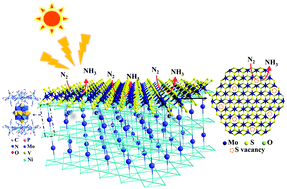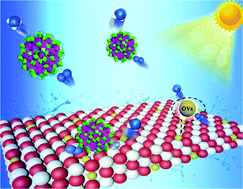Themed collection FOCUS: Photocatalysis

Understanding the role of Ce sites for boosting PEC-NIRR without externally applied potentials
Ce–BiVO4 was successfully designed for realizing efficient PEC-NIRR without externally applied potentials (0 V vs. RHE).

Inorg. Chem. Front., 2023,10, 2060-2066
https://doi.org/10.1039/D2QI02764J
Gold–nickel phosphide heterostructures for efficient photocatalytic hydrogen peroxide production from real seawater
A reusable Au plasmon-mediated Ni5P4 heterojunction is developed for direct H2O2 photosynthesis from earth-abundant seawater, ensuring a remarkable solar-to-H2O2 conversion efficiency of 0.29%.

Inorg. Chem. Front., 2023,10, 1907-1918
https://doi.org/10.1039/D2QI02662G
Ultrathin black TiO2 nanosheet-assembled microspheres with high stability for efficient solar-driven photocatalytic hydrogen evolution
We applied a small amine molecule protective agent to synthesize high-thermally stable black TiO2 with high specific surface area, broad optical absorption, and increased charge separation, which exhibits excellent photocatalytic performance.

Inorg. Chem. Front., 2023,10, 1153-1163
https://doi.org/10.1039/D2QI02596E
Fabricating BiVO4/FeOOH/ZnFe-LDH hierarchical core–shell nanorod arrays for visible-light-driven photoelectrochemical water oxidation
In this paper, porous BiVO4 nanorod arrays were encapsulated with FeOOH and ZnFe layered double hydroxide (ZnFe LDH) for the construction of hierarchical structures to achieve excellent transfer and separation of photogenerated electron–hole pairs.

Inorg. Chem. Front., 2022,9, 6431-6440
https://doi.org/10.1039/D2QI01165D
Minutely dispersed ruthenium in tremella-like N-doped carbon for enhanced visible-light-driven photocatalytic hydrogen production by CdS quantum dots
The employment of Ru/NC effectively retards the recombination of charge carriers by the storage and consumption of photo-excited electrons, achieving a significantly improved activity for H2 evolution, which is 21 times higher than that of bare CdS QDs.

Inorg. Chem. Front., 2022,9, 4999-5007
https://doi.org/10.1039/D2QI01259F
Photocatalytic CO2 reduction on Cu single atoms incorporated in ordered macroporous TiO2 toward tunable products
The Cu/3DOM-TiO2 photocatalyst exhibits high performance toward CO2 to CH4 conversion in a gas–solid system while producing C2H4 in a liquid–solid system.

Inorg. Chem. Front., 2022,9, 4753-4767
https://doi.org/10.1039/D2QI01155G
Turning off the “shunt channel” by coating with CoFe layered double hydroxide nanocrystals for efficient photoelectrocatalytic water splitting
Tiny and crystalline CoFe(C) nanoparticles can close the “shunt channel” between the cocatalyst and the substrate, and the recombination of photogenerated charge caused by back-reaction is inhibited.

Inorg. Chem. Front., 2022,9, 4685-4694
https://doi.org/10.1039/D2QI00760F
Ultrathin tungsten-doped hydrogenated titanium dioxide nanosheets for solar-driven hydrogen evolution
Ultrathin tungsten-doped hydrogenated TiO2 (W-h-TiO2) nanosheets are highly efficient for photocatalytic hydrogen production by water splitting without a noble metal cocatalyst.

Inorg. Chem. Front., 2022,9, 4470-4477
https://doi.org/10.1039/D2QI00978A
Tandem ZnCo-porphyrin metal–organic frameworks for enhanced photoreduction of CO2
A bimetallic ZnCo-porphyrin metal–organic framework (ZnCo-BMOF) nanosheet comprised of photosensitizers (Zn porphyrin) and catalysts (Co porphyrin) was developed for efficient photoreduction of CO2 to CO.

Inorg. Chem. Front., 2022,9, 4369-4375
https://doi.org/10.1039/D2QI00845A
Cyanamide-defect-induced built-in electric field in crystalline carbon nitride for enhanced visible to near-infrared light photocatalytic activity
Carbon nitride materials have achieved great accomplishments in solar-to-hydrogen energy conversion under visible light.

Inorg. Chem. Front., 2022,9, 4320-4328
https://doi.org/10.1039/D2QI00715K
An efficient strategy to boost the directed migration of photogenerated holes by introducing phthalocyanine as a hole extraction layer
Phthalocyanine with adjustable band energy and a binding group acts as a hole extraction layer to accelerate hole transfer from Ti-Fe2O3 to CoPi, and thus improves the PEC water oxidation performance of Ti-Fe2O3.

Inorg. Chem. Front., 2022,9, 3915-3923
https://doi.org/10.1039/D2QI00701K
Light induced ammonia synthesis by crystalline polyoxometalate-based hybrid frameworks coupled with the Sv-1T MoS2 cocatalyst
A series of crystalline polyoxometalate-based hybrid frameworks coupled with rich sulfur vacancy 1T MoS2 through the hydrothermal growth strategy are presented towards light induced ammonia synthesis.

Inorg. Chem. Front., 2022,9, 3828-3838
https://doi.org/10.1039/D2QI01003H
Interstitially O-doped CdxZn1−xS solid solution derived from chalcogenide molecular clusters for photocatalytic hydrogen evolution
An Oi-doped CdxZn1−xS solid solution with rich VS can trap holes and electrons for carrier separation to enhance photocatalytic activity.

Inorg. Chem. Front., 2022,9, 3771-3778
https://doi.org/10.1039/D2QI00497F
Assembling lanthanide–transition metal clusters on TiO2 for photocatalytic nitrogen fixation
A model for photocatalytic nitrogen fixation was constructed by assembling lanthanide–transition metal (4f–3d) clusters on TiO2. Ln52Ni56 not only acts as a tool to improve charge separation but also enriches oxygen vacancies.

Inorg. Chem. Front., 2022,9, 2862-2868
https://doi.org/10.1039/D2QI00628F
Ultrathin black phosphorus as a pivotal hole extraction layer and oxidation evolution co-catalyst boosting solar water oxidation
A large built-in electric field was formed due to the unequal work functions between BP and WO3, which is crucial for extracting photo-generated holes.

Inorg. Chem. Front., 2022,9, 2938-2944
https://doi.org/10.1039/D2QI00120A
Nickel phosphonate-derived Ni2P@N-doped carbon co-catalyst with built-in electron-bridge for boosting photocatalytic hydrogen evolution
Ni2P@CN is employed to construct a novel Cd0.5Zn0.5S/Ni2P@CN composite photocatalyst which guarantees highly efficient interfacial charge separation and transfer between Ni2P@CN and Cd0.5Zn0.5S, resulting in enhanced photocatalytic activity.

Inorg. Chem. Front., 2022,9, 1964-1972
https://doi.org/10.1039/D2QI00064D
Efficient H2 evolution on Co3S4/Zn0.5Cd0.5S nanocomposites by photocatalytic synergistic reaction
To achieve high photocatalytic efficiency of H2 evolution, promoting the utilization rate of photogenerated charge carriers by photocatalytic synergistic reaction is an efficient strategy.

Inorg. Chem. Front., 2022,9, 1943-1955
https://doi.org/10.1039/D1QI01617B
Highly efficient photosynthesis of H2O2via two-channel pathway photocatalytic water splitting
Highly efficient production of hydrogen peroxide via two-channel pathway and organic electron donor-free photocatalytic water splitting.

Inorg. Chem. Front., 2022,9, 1701-1707
https://doi.org/10.1039/D1QI01592C
Exfoliation-induced O-doped g-C3N4 nanosheets with improved photoreactivity towards RhB degradation and H2 evolution
Graphitic carbon nitride (g-C3N4) nanosheets exfoliated from their bulk-sized counterparts are limited by a quantum size effect-induced widened bandgap.

Inorg. Chem. Front., 2022,9, 1423-1433
https://doi.org/10.1039/D1QI01625C
A CdS/MnS p–n heterojunction with a directional carrier diffusion path for efficient photocatalytic H2 production
A CdS/MnS p–n heterojunction is prepared. The H2 production rate is 5.92 mmol g−1 h−1 with the apparent quantum efficiency of 5.63% at 420 nm, which is 10.57 times and 49.33 times higher than that of CdS nanorods and MnS, respectively.

Inorg. Chem. Front., 2022,9, 1100-1106
https://doi.org/10.1039/D1QI01632F
In situ synthesis of N-doped TiO2 on Ti3C2 MXene with enhanced photocatalytic activity in the selective reduction of nitrate to N2
Photocatalysis exhibits promise in the reduction of nitrates into harmless dinitrogen.

Inorg. Chem. Front., 2022,9, 1195-1207
https://doi.org/10.1039/D1QI01614H
Self-assembled transition metal chalcogenides@CoAl-LDH 2D/2D heterostructures with enhanced photoactivity for hydrogen evolution
Electrostatic self-assembly offered an effective and universal strategy for innovatively constructing a class of CoAl-LDH/transition metal chalcogenides 2D/2D heterojunctions for boosted photocatalytic H2 evolution.

Inorg. Chem. Front., 2022,9, 994-1005
https://doi.org/10.1039/D1QI01603B
Robust charge carrier engineering via plasmonic effect and conjugated Π-framework on Au loaded ZnCr-LDH/RGO photocatalyst towards H2 and H2O2 production
Au loaded ZnCr-LDH/RGO ternary photocatalyst for H2 and H2O2 production under visible light illumination.

Inorg. Chem. Front., 2022,9, 559-576
https://doi.org/10.1039/D1QI01284C
About this collection
Inorganic Chemistry Frontiers is delighted to introduce you the following collection of articles on “Photocatalysis”. Articles featured in our focus collections are handpicked by Editors. We hope you find them enjoyable to read .